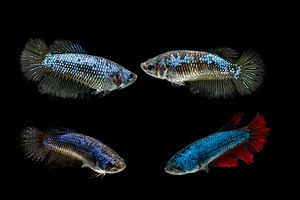Betta fish are common aquarium pets and command instant attention thanks to their beauty. Their bright, full range of colors and different fin and tail shapes make them a favorite fish. But a betta fish hanging out at the bottom of the tank is not something fish owners like to see. Here are 13 reasons why your betta fish might be laying at the bottom of its tank and what you can do to help.
1. Your Fish is Sleeping

Bettas also sometimes enjoy resting on leaves or leaf hammock decorations near the surface of the water.
©MR.AUKID PHUMSIRICHAT/Shutterstock.com
If all the parameters of your tank are within the normal range for your betta fish, then it’s likely your fish is just taking a snooze. Fish do need to sleep, though they don’t always do it in ways we recognize.
Betta fish will often find a place they like to rest and stick with it. In planted tanks, this might be under some shady leaves near the bottom of the tank. Other bettas like sleeping directly on the substrate. Some will even sleep vertically! Try to figure out what their pattern is to help overcome any unnecessary concerns.
As long as your fish is eating normally and water parameters like pH, nitrate, ammonia levels, and temperature are normal, then this behavior doesn’t require too much concern. If it starts occurring during the day when the fish is normally active and awake, consider some of the other potential reasons on this list.
2. Exhaustion

Many betta fish in the wild will have much shorter fins and usually will be more neutral in color.
©Arunee Rodloy/Shutterstock.com
Older betta fish get tired easily. This is usually due to their breeding. Having large, showy fins takes a lot of energy to force through the water while swimming. The average betta fish lives to be between two and four years old. If you’ve had your betta fish for a while, this could just be age taking its toll on your fish’s energy levels.
Age related rest might be more obvious when your fish is swimming around and suddenly decides to rest at the bottom of the tank. Shortly after, they might get right back to swimming. There’s nothing that can be done about age, unfortunately. If you notice this behavior in your betta and chalk it up to age, do your best to give it as stress-free a life as possible to ensure it can live the rest of its days happily.
3. Swim Bladder Issue

This issue might come about suddenly and can present itself in a few different ways.
©Napat/Shutterstock.com
Bony fish rely on an organ called the swim bladder to stay afloat. When your fish inexplicably starts swimming oddly or is regularly lying at the bottom of the tank, that’s a sign your fish might have an issue with its swim bladder. Sinking, bloating, or a curved back can all be signs of swim bladder disorders.
Fortunately, this doesn’t mean certain death. It might be a sign you need to perform better or more frequent water changes or make some adjustments to your betta’s diet. A pinch of aquarium salt can also help with bloating and other problems related to swim bladder disorders.
4. Poor Filtration

Setting up and maintaining a quality filter will help with keeping the tank clean and the health of the fish.
©Ladanifer/iStock via Getty Images
While some people keep bettas in very low-tech tanks without filtration, this isn’t the best for the fish. A lack of filtration combined with infrequent water changes can breed a host of issues for your betta, such as poisoning, swim bladder issues, or even death.
Filters also harbor beneficial bacteria to help keep the water quality suitable for your betta. Be sure the filter’s flow isn’t too strong: this can push your betta, exhausting it and causing potential physical damage to the delicate fish.
5. Nitrate Poisoning

Overcrowding can lead to over-feeding and massive amounts of waste, all of which produce nitrates.
©attakorn sanguanwong/Shutterstock.com
A consequence of poor filtering or inadequate care is nitrate poisoning. This is most common after cycling a tank, as it’s the last step in the degradation of ammonia. Levels have to be pretty high to see symptoms of nitrate poisoning that didn’t appear from ammonia or nitrite poisoning beforehand. You might notice a sudden boom in algae growth: this is a sign of high levels of nitrate, too. Additionally, an influx of fish waste can lead to a spike in nitrates.
If nitrate levels are high, you have to change out nearly 100% of the water as this is the only way to remove them. Avoid using tap water to refill or top off your tank unless you’re adding an aquarium-approved water conditioner. If this is a new tank or if you’ve added some tank mates, stay on top of testing the water regularly until the parameters are consistently within the normal range. Nitrate levels should always be below 20 ppm (parts per million).
6. Incorrect pH

Water parameter test kits usually come with a pH test.
©Ivan-balvan/ via Getty Images
The right pH for a betta fish is relatively neutral; ideally, it will be between 6.8 and 7.5. Any higher or lower can cause your betta to act funny or start declining in health. Having a fish hanging out at the bottom of the tank outside of its normal sleep schedule could be an indication of an incorrect pH level. In addition to the potential for it to start lazing about at the bottom of the tank, incorrect pH levels or frequent fluctuations can stress your fish and make it more susceptible to illnesses.
Certain substrates or additions to your tank, like driftwood and peat moss, lower the pH. Be sure you’re mindful of what you add to the tank, so it doesn’t lower or raise the acidity too much.
7. Ammonia Poisoning

Testing your aquarium’s water regularly is an important part of maintenance.
©Ladanifer/Shutterstock.com
Ammonia is the first chemical that results from rotting food or waste, and eventually turns into nitrites, then nitrates. At the ammonia level, it can be easily removed using a water conditioner or by doing a 25% water change. High levels of ammonia can cause your fish’s gills to essentially burn. If they’re lying at the bottom of the tank, the ammonia levels may be severely high. Other signs can include inflamed eyes, lethargy, and loss of appetite. Ideally, ammonia levels should be as close to zero as possible. Ammonia alert sensors can be added to your tank to let you know of a spike.
Doing the 25% water change immediately upon noticing any of these symptoms can provide some relief for your betta and prevent the issue from worsening. From here, it’s best to continue monitoring the water by doing some regular testing. Always consider that spikes in ammonia, nitrite, or nitrate might occur upon adding more creatures to your tank. Overfeeding can also cause spikes in these chemicals.
8. Poor Diet
A bad diet can catch up to anyone, fish included. Low-quality fish pellets are not going to contain everything your betta needs to stay healthy and often contain corn or other filler products that are not easily digested by your fish. This can lead to bloating, lethargy, and a lack of appetite. Also, it could be the reason your betta fish is hanging out on the bottom of the tank.
High-quality foods that contain all the necessary vitamins your fish would get from natural forage will help keep your betta vigorous and full of life. Getting food specifically for betta fish can help ensure they’re getting everything they need. You can give them an assortment of foods by providing treats like brine shrimp or frozen bloodworms too. These treats are not meant to replace a high-quality betta fish food.
9. Temperature Issue

Rice paddies have comfortable water temperatures and calm waters that captive bettas still prefer.
©iStock.com/Trail Sun
Betta fish hail from Thailand and surrounding areas. Water in the marshes and rice paddies in this area are relatively warm, in the 75-80°F range. Too cold and the immune system of your betta fish can slowly start to decrease in effectiveness. This makes your fish much more vulnerable to illnesses and can make small stressors take a huge toll. Water that is too hot can accelerate their metabolism and even the aging process.
A heater set to the appropriate range will maintain the right temperature for your betta fish to remain comfortable in its environment.
10. Bad Tank Mates

Bettas like to be the prettiest thing (and usually the only thing) in the tank.
©Patcharanat Sriboonruang/Shutterstock.com
The other name for betta fish is “Siamese fighting fish”. This is, as you probably guessed, because they fight almost any other fish. So, housing multiple betta fish together isn’t usually recommended. Most other fish that are its size or smaller are also subject to being bullied by the betta. Alternatively, other large and aggressive fish, like cichlids, can stress out the betta fish and cause it to act out. As we know, stress can have a detrimental effect on any living being’s health.
Minimize the stress your bettas are under by only housing them with the appropriate tank mates. Sometimes, the best thing to do is keep your betta alone. Small creatures like shrimp or snails usually do well with them. Plecostomus fish don’t bother bettas, but your betta might bother them, so proceed with caution if you want to add algae-eaters to your tank.
11. Lack of Enrichment

Feeding live brine shrimp to your betta fish can also give it something different to do on the occasion.
©airdone/Shutterstock.com
Like people and other animals, betta fish can get bored. When they get bored, they can get stressed. Stress in a betta fish can manifest itself as a lazy-looking fish that hangs out at the bottom of the tank. Having room for plants or other small tank mates like shrimp or snails can help stave off boredom for this type of fish, especially since they’re usually better without other similar-sized fish around.
If your tank is pretty bare but all the water parameters are right, you might just need to add a way for your fish to have a bit of fun or something to do to perk up its spirit.
12. Too Small of a Tank

Small tanks also don’t usually have room for a filter and heater, both of which are necessary additions.
©Sunny_Smile/Shutterstock.com
Contrary to the belief of those who keep betta fish in a one-gallon bowl, these fish prefer to have some space to roam. Ideally, you’d have your betta in a five-gallon or larger tank. If you’re giving them some approved tank mates, then you need a larger tank to accommodate the extra fish.
Too small of a space for your betta fish can lead to it lying on the bottom of the tank and being lethargic. Smaller tanks also accumulate waste more easily, leading to more frequent water changes and testing. Give your betta some extra room for it to interact with its environment. Enrichment can go a long way in guaranteeing a happy, interesting life for your betta.
13. Disease

Fish, like other animals, sometimes also need medicine to get better.
©mangpor_2004/iStock via Getty Images
Unfortunately, there are many different diseases your fish can get that might cause it to lay at the bottom of the tank. Here are the two most common ones:
Dropsy
This is a bacterial infection that can cause swelling and protruding fins, lethargy, and loss of appetite. If not treated, your betta could die. This bacterium usually will take hold of a fish that is already in a compromised state of health, so ensuring you’re feeding the right diet and properly cycling the tank is important in prevention.
If you suspect your betta fish has dropsy, there are medications available that you can use to treat the water in the tank and therefore, your fish. To avoid over-reliance on medication, try to figure out the root of the problem to prevent the issue from happening again.
Columnaris
While this bacterial disease doesn’t directly cause your fish to lay at the bottom of the tank, it does reduce its appetite which might make it lethargic and less able to swim for extended periods of time. Other symptoms include open sores or damage to the fins. This can be treated using antibacterial medications. However, you should probably quarantine the fish in a clean container or tank to administer the medicine. You should also give the tank and any decorations or plants a thorough wash. After you finish cleaning and cycling the tank, you can treat the water again.
Summary of Reasons
| Reasons Why Your Betta is Laying at the Bottom of the Tank |
|---|
| 1. Your Fish is Sleeping |
| 2. Exhaustion |
| 3. Swim Bladder Issue |
| 4. Poor Filtration |
| 5. Nitrate Poisoning |
| 6. Incorrect pH |
| 7. Ammonia Poisoning |
| 8. Poor Diet |
| 9. Temperature Issue |
| 10. Bad Tank Mates |
| 11. Lack of Enrichment |
| 12. Too Small of a Tank |
| 13. Disease |
Conclusions
Though they are relatively short-lived, betta fish are complex fish that require a loving and caring environment to thrive. Be sure you’re ready for this fish with the appropriate set-up and sized aquarium. A water testing kit can last a while. It only takes about 15-20 minutes to do all of the tests. This can be done every few days for new betta fish. Once your fish has been established, once-a-month checks are sufficient. This should help you stay on top of any changes in the water parameters that can lead to your betta lying at the bottom of the tank.
The photo featured at the top of this post is © 3623/Shutterstock.com
Thank you for reading! Have some feedback for us? Contact the AZ Animals editorial team.






